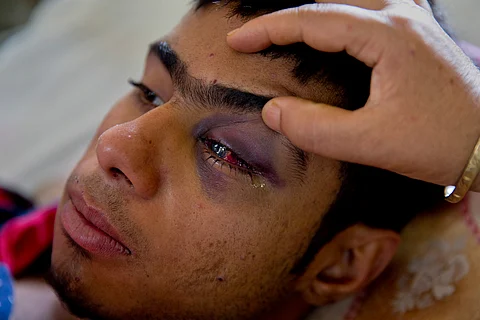

NEW DELHI: When the Central Reserve Police Force (CRPF) on Monday announced the use of tweaked ‘less lethal’ pellet guns in crowd control, it nuanced its message to neutralize the haunting memory of innocent Kashmiris who lost their eyesight in the street protests last year.
An investigation by New Indian Express into the ‘pellet tweak’ exposes CRPF’s claim of minimising injuries due to use of pellet guns by security forces. Many officers, speaking on the condition of anonymity, made it amply clear that pellet guns, even when aimed at the ankles of a protester, have a high probability of hitting the upper part of the body.
To start with, the officers said there’s no such thing called a pellet gun. The correct term is a ‘12-bore shotgun’ that fires very small shots like fine ball bearings of lead. Each no. 9 cartridge that CRPF uses in the Kashmir Valley holds about 485-500 shots.
“A shotgun is basically a smooth pipe, the barrel,” one official said. “When the shots emerge from the barrel, they fly in the form of a cone. The gas propelling the shots expands in all directions, forming a conical zone. As the shots travel, they disperse and the cone becomes wider.”
CRPF director-general Durga Prasad, who retired Tuesday, claimed that the modified pellet gun would have a ‘deflector’ fixed to the muzzle -- just like the visor of a baseball cap -- so that the shot does not go up. It would be confined to the bottom half of the cone.
This, however, may not be true, said an officer. He said the deflector could at the very cover a couple of inches, which would mean that it can stop only those shots that strike the deflector.
“All the 500 shots fired from a pellet gun do not fly bunched in a tight ball. They fly loose. The trail is actually quite long. This means that some pellets travel at an angle that makes them escape the edge of the deflector,” the officer said.
Another officer pointed out that even the visor of a baseball cap does not block all the light of the sun.
“This means that some of the pellets would continue to move in the upper half of the cone, and end up striking the upper part of a protester’s body anyway,” he said. Most importantly, it is not the dispersion of the pellets in the cone that is material but the slight movement of the hand holding the gun that accounts for the trajectory.
“You are not holding the gun in a vice, which might hold your firearm tight for pinpoint accuracy. Human hands do tremble. In any case, there is little aiming done in a real-life situation,” the officer added.
One officer of the J&K Police said, “Suppose the constable is firing at 50 yards range. If his barrel moves by as little as two degrees, the difference could be as much as 6 feet off the mark.
“Even if you aim at the ankle of a protester and your barrel moves by two degrees, you could still shoot a six feet tall man in the head. When you are firing pellets, it means that a very substantial number of shots would hit the upper part of the body,” he said. In reality, the barrel might move more than just 2 degrees.
“The committee which hurriedly approved the PAVA shells as an alternative to the pellet gun did not do its job scientifically. The lied to please the government. On what basis did they make claims about its efficacy,” an official questioned.